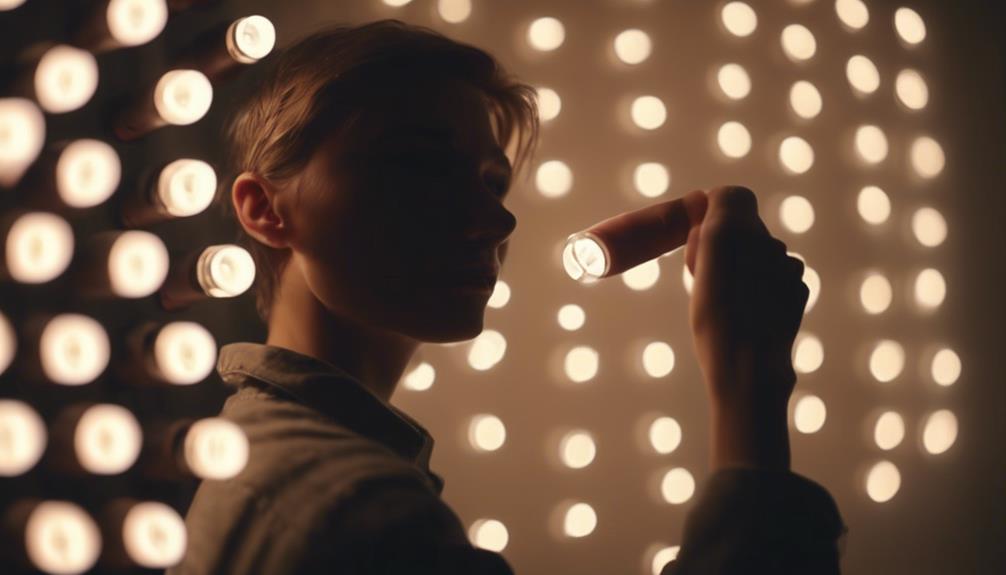LED lights have the potential to cause headaches as a result of their blue light emissions. Factors such as flickering and color temperatures are significant contributors to this discomfort. Exposure to blue light can result in migraines, eye strain, and fatigue, affecting individuals in various ways. The French authorities have issued warnings regarding the negative effects of LED light on retinas and sleep patterns. Managing symptoms involves recognizing the connection between LED lights and headaches. Implementing strategies such as using green LED lights, wearing blue light-blocking glasses, and adjusting light intensity can help alleviate discomfort. To find effective solutions for these issues, it is important to further investigate the impact of LED lights on health.
Key Takeaways
- LED lights can trigger headaches due to blue light emissions.
- Blue light sensitivity from LEDs can lead to eye strain and fatigue.
- Flickering effect in LED lights can worsen headache symptoms.
- High brightness levels and color temperatures impact light sensitivity.
- French authorities warn about the harmful effects of blue light emitted by LEDs.
LED Light Sensitivity Overview
LED light sensitivity is an essential issue for many individuals, particularly those exposed to blue light emissions. The high blue light concentration in LED lights is a key factor in triggering headaches and migraines in susceptible individuals. Exposure to the flickering of LED lights can also lead to visual discomfort, eye strain, and headaches.
Different color temperatures of LED bulbs may impact light-sensitive individuals differently, potentially exacerbating these symptoms. LED lights are commonly found in various devices such as computer screens, TVs, and smartphones, contributing to light sensitivity and headaches in those affected.
Individuals experiencing migraines, headaches, or eye strain may find relief by minimizing exposure to LED lights, especially those emitting high levels of blue light. Understanding the impact of different color temperatures and the potential for LED lights to induce discomfort is essential for managing light sensitivity issues related to these light-emitting diodes.
Impact of Blue Light Emission

Blue light emissions, particularly from certain sources, can have a significant impact on causing headaches and other related symptoms in individuals sensitive to such light. LED lights are known to emit blue light, which can trigger headaches, migraines, eye strain, and fatigue. In comparison to fluorescent light, LED lights emit even more harmful blue light, potentially exacerbating these symptoms. Exposure to high intensity blue light from LEDs can disrupt retinas and biological sleep rhythms, leading to headaches. Additionally, short-term exposure to blue light from LEDs can cause eye damage and sleep disturbances, further contributing to headaches. French environmental authorities have also issued warnings about the detrimental effects of blue light from LEDs, emphasizing its role in causing headaches.
| Impact of Blue Light Emission |
|---|
| LED lights |
| Blue light |
| Headaches |
Connection to Migraines

Exposure to certain types of lighting, particularly those commonly found in electronic devices, may exacerbate migraine symptoms in susceptible individuals. LED lights, known for their high blue light content, have been linked to triggering headaches and migraine attacks. The blue light sensitivity of some individuals can lead to increased eye strain, fatigue, and headache disorders upon exposure to LED lighting. Additionally, the flickering effect often present in LED lights can further worsen headache and migraine symptoms in affected individuals.
Given that LED lights are prevalent in screens of electronic devices like computers and TVs, individuals prone to migraines should be cautious of prolonged exposure to such lighting sources. Understanding the connection between LED lights and migraines is important for mitigating potential triggers and managing symptoms effectively. By being mindful of the impact of LED lighting on headache disorders, individuals can take proactive steps to create environments that are more conducive to their well-being.
Flickering Effects on Headaches

The essential flickering effect from certain types of lighting, especially LEDs, can greatly worsen headaches in susceptible individuals. LEDs may cause headaches due to their more pronounced flicker effect compared to other lighting sources. Dimming LEDs can exacerbate this effect, potentially worsening headaches.
Liquid crystal display screens, such as those in computers and TVs that utilize LEDs for backlighting, flicker at a rate of 60 times per second, which can trigger migraine attacks in susceptible individuals. The flickering effect of LEDs, especially in white light combinations, has been linked to the exacerbation of headaches and migraines.
For those prone to headaches, particularly migraine sufferers, exposure to the flickering from LEDs, especially in devices like computer and TV screens, can lead to an increase in headache attacks. It's vital for individuals sensitive to such stimuli to be mindful of the potential impact of flickering light sources on their headaches.
Strategies for Minimizing Discomfort

To alleviate discomfort caused by LED lights, individuals can incorporate specific strategies to minimize the likelihood of headaches and migraines. Using green LED lights can help reduce the chances of experiencing headaches and migraines.
Additionally, wearing blue light-blocking glasses can be beneficial in reducing discomfort from prolonged exposure to LED lights. It's recommended to limit exposure to bright LED screens, especially in dark environments, as this can help prevent headaches.
Avoiding the dimming of LED lights is advised, as dimming can increase flickering and potentially lead to discomfort. Experimenting with color filtering programs on LED devices is another effective way to reduce eye strain and fatigue, hence minimizing the risk of headaches and migraines.
Choosing LED Light Filters

LED light filters play an important role in reducing the harmful effects of blue light emitted by LEDs. These filters are designed to block specific wavelengths of light that contribute to headaches and eye strain.
By using LED light filters, individuals sensitive to bright lights can find relief and experience improved eye health and comfort. The selection of the right LED light filters is essential in optimizing the lighting environment and minimizing the risk of headaches caused by blue light exposure.
These filters work by reducing the amount of blue light that reaches the eyes, which can help alleviate discomfort and promote a more soothing lighting atmosphere. When choosing LED light filters, it's essential to take into account their ability to effectively reduce the harmful effects of blue light while maintaining adequate lighting for visibility and task performance.
Adjusting Light Intensity

Adjusting the intensity of light emitted by LEDs can greatly impact the occurrence of headaches and migraines. When it comes to LED lights, adjusting the brightness settings is important in managing potential triggers. Dimming LED lights too much can increase the flicker effect, potentially leading to headaches. Conversely, setting the brightness too high can cause discomfort and eye strain. Finding the right balance is key to creating a comfortable environment and reducing the risk of headaches.
In addition to brightness, adjusting the blue light intensity from LEDs can also play a role in alleviating headache triggers. By properly adjusting the light intensity of LED lights, individuals can reduce discomfort, eye strain, and the likelihood of experiencing headaches or migraines. Taking the time to optimize these settings can go a long way in promoting a headache-free environment.
Managing Light Exposure

To effectively manage light exposure and reduce the risk of headaches from LED lights, individuals can consider:
- Wearing blue light-blocking glasses.
- Using dimmable LED lights.
- Positioning light sources strategically to avoid glare.
It's also advisable to:
- Take regular breaks from prolonged LED exposure.
- Utilize color filters or screen overlays to minimize the impact of blue light.
Light Intensity Effects
Managing light exposure efficiently can greatly reduce the incidence of headaches triggered by high-intensity blue light from LEDs. Exposure to intense LED lights can lead to symptoms like headaches, migraines, eye strain, and fatigue. By avoiding prolonged exposure to bright LED lights and adjusting their intensity, individuals can minimize headache triggers.
Specialized eyewear or color filtering programs can also help mitigate the negative effects of intense LED light exposure. If experiencing eye discomfort or headaches, it may be necessary to reassess LED light intensity and exposure levels.
To manage light intensity effects effectively, it's advisable to limit the use of LED-lit devices in the evening and make sure proper lighting conditions are maintained to reduce the impact on headaches.
Timing of Exposure
Limiting exposure to LED-lit devices before bedtime can greatly reduce the likelihood of experiencing headaches. To manage LED exposure effectively, individuals can consider the following tips:
- Avoiding bright screens in dark surroundings and using nighttime driving glasses can minimize the impact of LED lights on headaches.
- Taking breaks from looking at LED lights and ensuring good lighting in your work environment can help prevent headaches.
- Using color filtering programs and specialty-tinted eyewear can mitigate the negative effects of LED light exposure on headaches.
- Experimenting with different lighting options to find what works best for you is key to managing the timing of LED light exposure and headaches.
Light Source Positioning
Properly positioning LED light sources is vital in reducing glare and eye strain, enhancing overall comfort, and minimizing potential headaches. By adjusting the angle and distance of LED lights, direct light exposure can be minimized, thereby decreasing eye discomfort.
Placing LED lights overhead or behind can prevent direct glare into the eyes, offering a more comfortable lighting environment. Strategic positioning of LED lights can also create ambient lighting, reducing the harshness of direct lighting that can contribute to eye strain.
Managing light exposure through effective LED light positioning is important for alleviating headaches and promoting visual comfort. By paying attention to how LED lights are placed and directed, individuals can mitigate potential issues related to glare and eye strain.
Conclusion and Recommendations

LED lights, particularly those emitting blue light, can indeed trigger headaches and migraines due to their high energy and short wavelength. Opting for green LED lights and utilizing color filtering programs or specialty-tinted eyewear can help mitigate these effects.
Managing LED glare, limiting screen exposure in dark environments, and exploring different lighting options are recommended strategies to alleviate LED-induced headaches.
LED Light Brightness
Importance levels of LED lights play an important role in exacerbating symptoms for light-sensitive individuals, potentially leading to headaches and discomfort. When considering LED light brightness, it's essential to keep in mind the following points:
- High brightness levels can intensify light sensitivity, triggering headaches.
- Blue light emitted by LED bulbs can worsen symptoms for those sensitive to light.
- Different color temperatures of LED lights may impact individuals with light sensitivity.
- Flickering in LED lights, a common occurrence in some models, can provoke headaches and visual disturbances.
Being mindful of these factors can help mitigate the adverse effects of LED lights on individuals prone to headaches and light sensitivity.
Health Impacts
Excessive exposure to blue light emitted by LED lights can have detrimental effects on individuals' health, including triggering headaches, migraines, eye strain, and fatigue due to their high energy output. This type of light can disrupt sleep patterns, cause eye damage, and lead to symptoms like double vision and dizziness. Moreover, blue light from LEDs can exacerbate migraine attacks and light sensitivity, impacting overall well-being.
Choosing green LED lights over blue, white, or red LEDs may help reduce the likelihood and severity of headaches and migraines. Managing LED light sensitivity involves strategies such as avoiding dimming screens, utilizing color filters, and limiting exposure in the evening to alleviate symptoms. It's essential to be mindful of the potential health impacts associated with prolonged exposure to LED lights, particularly those emitting blue light.
Frequently Asked Questions
Can You Be Sensitive to LED Lights?
Being sensitive to LED lights is important due to their potential to trigger headaches, migraines, eye strain, and discomfort, especially for individuals with photophobia or light sensitivity.
Flickering from LEDs can exacerbate symptoms in those sensitive to light. Additionally, LED screens on devices like computers and TVs may worsen headache and migraine symptoms.
It's vital for individuals with sensitivities to be mindful of their exposure to LED lighting to minimize any adverse effects.
Why Do Flickering Lights Cause Headaches?
Flickering lights can trigger headaches due to disruptions in brain activity caused by rapid changes in light intensity. The flicker effect of LEDs can lead to visual discomfort, eye strain, and headaches in sensitive individuals.
Rapid flickering from LEDs, especially at frequencies below 100 Hz, impacts alpha waves in the brain, potentially causing headaches. Individuals with light sensitivity are at increased risk of headaches from prolonged exposure to flickering LED lights.
What Are the Harmful Effects of LED Lights on Eyes?
LED lights emit high-intensity blue light, which can lead to eye strain, headaches, and vision problems. Prolonged exposure to this light may disrupt retinas and affect the biological sleep rhythm.
French environmental authorities have cautioned against the harmful effects of blue light from LEDs on eyes, including retinal damage and visual discomfort. To mitigate these risks, it's advisable to take breaks from LED exposure and guarantee appropriate lighting in work environments.
What Light Bulbs Cause Migraines?
Certain LED light bulbs, especially those emitting blue light, are known to trigger migraines. High-intensity blue light from LEDs can lead to eye strain and fatigue, contributing to headaches. Color temperatures like white and blue in LED bulbs may worsen migraine symptoms.
Additionally, flickering from LED lights can also play a role in causing headaches, visual discomfort, and even migraine attacks. Individuals sensitive to light should be cautious with LED bulbs due to these potential effects.
Conclusion
In the world of lighting choices, LED lights can be a double-edged sword. While they offer energy efficiency and longevity, their blue light emission may trigger headaches for some individuals.
By understanding the impact of flickering effects and adjusting light intensity, one can mitigate discomfort. Choosing LED light filters and managing light exposure are key strategies for minimizing potential headaches.
Remember, when it comes to LED lights and headaches, knowledge is power. Choose wisely to illuminate without causing pain.





